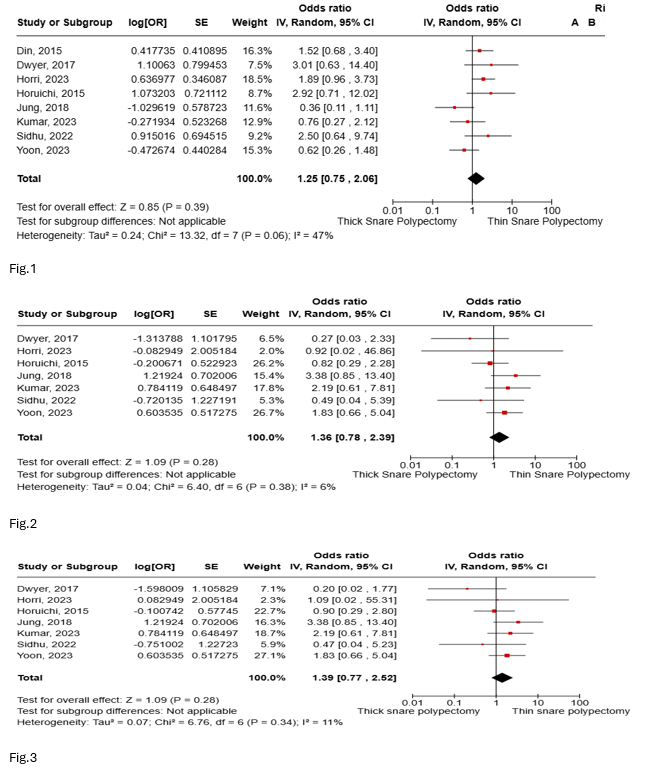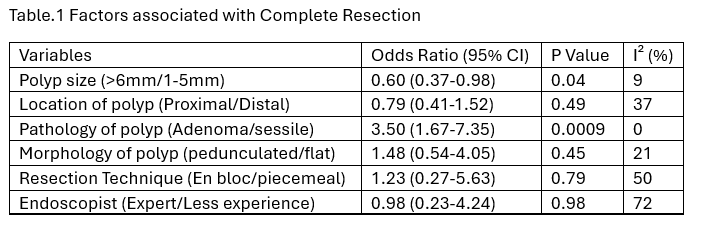Monday Poster Session
Category: General Endoscopy
P2978 - A Systematic Review and Meta-Analysis of Clinical Efficacy and Safety Comparing Cold Snare Polypectomy Using Thin-wire Versus Thick-wire Snares for Small Colorectal Polyps
Monday, October 27, 2025
10:30 AM - 4:00 PM PDT
Location: Exhibit Hall

Shahryar Khan, MD
University of Kansas Medical Center
Kansas City, KS
Presenting Author(s)
Shahryar Khan, MD1, Usama Ali, MBBS2, Ehtisham Khattak, MBBS3, Muhammad Waqar Elahi, MD4, Mashal Alam Khan, MBBS5, Falak Hamo, MD6, Fariha Hasan, MD7, Noemy Coreas, MD8, Tuba Esfandyari, MD, FACG9
1University of Kansas Medical Center, Kansas City, KS; 2Khyber Medical University, Peshawar, North-West Frontier, Pakistan; 3Khyber Medical University, Islamabad, Islamabad, Pakistan; 4West Virginia University School of Medicine, Morgantown, WV; 5Khyber Medical University, Kansas City, KS; 6University of Kansas Medical Center, Overland Park, KS; 7Cooper University Hospital, Camden, NJ; 8National University of El Salvador, El Salvador, San Salvador, El Salvador; 9The University of Kansas Health System, Kansas City, KS
Introduction: Cold snare polypectomy (CSP) is an established technique for the removal of small polyps (< 10 mm) owing to its safety and effectiveness. The comparative effectiveness of the different types of snares used in CSP is uncertain. We aimed to examine the usefulness of thin-wire snare (TN) versus thick-wire snare (TK) during CSP in small colorectal polyps.
Methods: We systematically searched Medline and Embase from their inception till May 15,2025. The primary outcome of interest in this meta-analysis was the complete resection rate (CR), defined as endoscopic en bloc resection of the entire lesion with histologically tumor-free margins, both horizontally and vertically. The secondary outcomes were adverse events, intraprocedural bleeding, polyp retrieval rates, presence of submucosa (SM) in the resected specimen, and factors associated with CR. The random-effects model was used to calculate the odds ratio (OR) with corresponding 95% confidence intervals of the desired outcomes. A p value of < 0.05 was considered statistically significant. Heterogeneity was assessed using the I2 Index. Study quality was assessed using the ROBINS-1 tool. Data analysis was performed using the Revman software (version 5.4.1).
Results: Eight studies, with a total population of 1, 553 were included in our meta-analysis. The participants had an average age of 63.9 and female comprised 40.5% of the population, respectively. The most common location for polyps was the proximal colon (57%), morphology was sessile (67%), and pathology was adenoma (92%). The mean polyp size was 6.5 mm ± 2 mm in both groups. Comparing both groups, no difference was found in CR (OR 1.25, 95% CI 0.75 to 2.06, I2 = 47%, Fig.1), adverse events (OR 1.36, 95% CI .78 to 2.39, I2 = 6%, Fig.2), polyp retrieval rates (OR 1.42, 95% CI .68 to 2.95), intraprocedural bleeding (OR 1.39, 95% CI .77 to 2.52, Fig.3), and SM in resected specimen (OR 1.33, 95% CI 0.82 to 2.18). Polyps size, and morphology were statistically significant factors associated with complete resection (Table.1).
Discussion: Our findings suggest that snare thickness does not have an additional beneficial effect on cold snare polypectomies. However, larger randomized studies are needed to evaluate factors beyond the snare design in CSP to improve outcomes.

Figure: Fig.1 Forrest plot of Complete resection. Comparison of Thick Versus Think Snare; Fig.2 Forrest plot of Adverse events. Comparison of Thick Versus Think Snare; Fig.3 Forrest plot of Intraprocedural bleeding. Comparison of Thick Versus Think Snare.

Figure: Table.1 Factors associated with Complete Resection
Disclosures:
Shahryar Khan indicated no relevant financial relationships.
Usama Ali indicated no relevant financial relationships.
Ehtisham Khattak indicated no relevant financial relationships.
Muhammad Waqar Elahi indicated no relevant financial relationships.
Mashal Alam Khan indicated no relevant financial relationships.
Falak Hamo indicated no relevant financial relationships.
Fariha Hasan indicated no relevant financial relationships.
Noemy Coreas indicated no relevant financial relationships.
Tuba Esfandyari indicated no relevant financial relationships.
Shahryar Khan, MD1, Usama Ali, MBBS2, Ehtisham Khattak, MBBS3, Muhammad Waqar Elahi, MD4, Mashal Alam Khan, MBBS5, Falak Hamo, MD6, Fariha Hasan, MD7, Noemy Coreas, MD8, Tuba Esfandyari, MD, FACG9. P2978 - A Systematic Review and Meta-Analysis of Clinical Efficacy and Safety Comparing Cold Snare Polypectomy Using Thin-wire Versus Thick-wire Snares for Small Colorectal Polyps, ACG 2025 Annual Scientific Meeting Abstracts. Phoenix, AZ: American College of Gastroenterology.
1University of Kansas Medical Center, Kansas City, KS; 2Khyber Medical University, Peshawar, North-West Frontier, Pakistan; 3Khyber Medical University, Islamabad, Islamabad, Pakistan; 4West Virginia University School of Medicine, Morgantown, WV; 5Khyber Medical University, Kansas City, KS; 6University of Kansas Medical Center, Overland Park, KS; 7Cooper University Hospital, Camden, NJ; 8National University of El Salvador, El Salvador, San Salvador, El Salvador; 9The University of Kansas Health System, Kansas City, KS
Introduction: Cold snare polypectomy (CSP) is an established technique for the removal of small polyps (< 10 mm) owing to its safety and effectiveness. The comparative effectiveness of the different types of snares used in CSP is uncertain. We aimed to examine the usefulness of thin-wire snare (TN) versus thick-wire snare (TK) during CSP in small colorectal polyps.
Methods: We systematically searched Medline and Embase from their inception till May 15,2025. The primary outcome of interest in this meta-analysis was the complete resection rate (CR), defined as endoscopic en bloc resection of the entire lesion with histologically tumor-free margins, both horizontally and vertically. The secondary outcomes were adverse events, intraprocedural bleeding, polyp retrieval rates, presence of submucosa (SM) in the resected specimen, and factors associated with CR. The random-effects model was used to calculate the odds ratio (OR) with corresponding 95% confidence intervals of the desired outcomes. A p value of < 0.05 was considered statistically significant. Heterogeneity was assessed using the I2 Index. Study quality was assessed using the ROBINS-1 tool. Data analysis was performed using the Revman software (version 5.4.1).
Results: Eight studies, with a total population of 1, 553 were included in our meta-analysis. The participants had an average age of 63.9 and female comprised 40.5% of the population, respectively. The most common location for polyps was the proximal colon (57%), morphology was sessile (67%), and pathology was adenoma (92%). The mean polyp size was 6.5 mm ± 2 mm in both groups. Comparing both groups, no difference was found in CR (OR 1.25, 95% CI 0.75 to 2.06, I2 = 47%, Fig.1), adverse events (OR 1.36, 95% CI .78 to 2.39, I2 = 6%, Fig.2), polyp retrieval rates (OR 1.42, 95% CI .68 to 2.95), intraprocedural bleeding (OR 1.39, 95% CI .77 to 2.52, Fig.3), and SM in resected specimen (OR 1.33, 95% CI 0.82 to 2.18). Polyps size, and morphology were statistically significant factors associated with complete resection (Table.1).
Discussion: Our findings suggest that snare thickness does not have an additional beneficial effect on cold snare polypectomies. However, larger randomized studies are needed to evaluate factors beyond the snare design in CSP to improve outcomes.

Figure: Fig.1 Forrest plot of Complete resection. Comparison of Thick Versus Think Snare; Fig.2 Forrest plot of Adverse events. Comparison of Thick Versus Think Snare; Fig.3 Forrest plot of Intraprocedural bleeding. Comparison of Thick Versus Think Snare.

Figure: Table.1 Factors associated with Complete Resection
Disclosures:
Shahryar Khan indicated no relevant financial relationships.
Usama Ali indicated no relevant financial relationships.
Ehtisham Khattak indicated no relevant financial relationships.
Muhammad Waqar Elahi indicated no relevant financial relationships.
Mashal Alam Khan indicated no relevant financial relationships.
Falak Hamo indicated no relevant financial relationships.
Fariha Hasan indicated no relevant financial relationships.
Noemy Coreas indicated no relevant financial relationships.
Tuba Esfandyari indicated no relevant financial relationships.
Shahryar Khan, MD1, Usama Ali, MBBS2, Ehtisham Khattak, MBBS3, Muhammad Waqar Elahi, MD4, Mashal Alam Khan, MBBS5, Falak Hamo, MD6, Fariha Hasan, MD7, Noemy Coreas, MD8, Tuba Esfandyari, MD, FACG9. P2978 - A Systematic Review and Meta-Analysis of Clinical Efficacy and Safety Comparing Cold Snare Polypectomy Using Thin-wire Versus Thick-wire Snares for Small Colorectal Polyps, ACG 2025 Annual Scientific Meeting Abstracts. Phoenix, AZ: American College of Gastroenterology.
